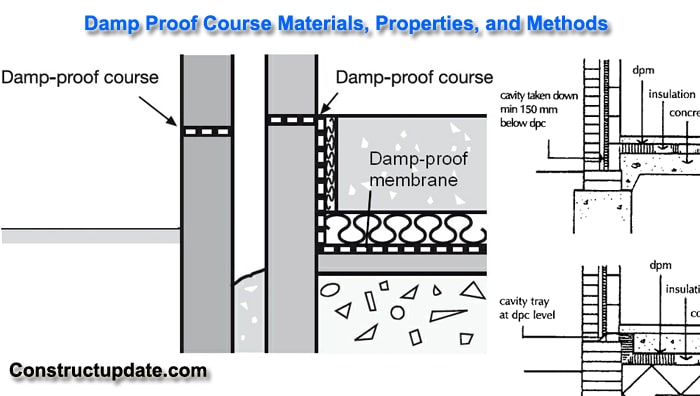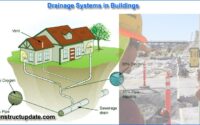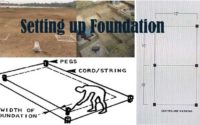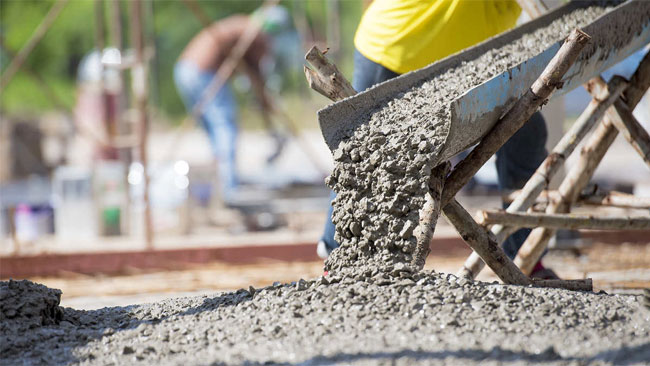What is Damp Proof Course (DPC) | DPC Materials, Properties, and Methods
What Is Damp Proof Course?
The damp proof course is an important layer for any building walls that is installed near the ground to keep the walls from becoming moist.
Excess moisture rising from the ground may be a problem in properties that do not have a damp protection layer installed. Excess moisture may wreak havoc on decorations, plaster, and even cause damp rot in uncovered wood.
In most homes, a damp-proof course of at least 150 mm should be installed above the walls. By poking through, a mortar course made of plastic DPC sheet or bitumen may surface.
Materials for Damp Proof Course (DPC)
Properties of Materials for DPC:
The following characteristics should be present in an efficient damp proofing material:
- Imperviousness.
- It should be sturdy and long-lasting, and it should be able to handle both dead and live loads without being damaged.
- Dimensionally stable should be the goal.
- Deliquescent salts like sulphates, chlorides, and nitrates should be avoided.

What are the features of DPC Material that are desirable?
The following are some of the benefits of DPC material:
- It should be impenetrable.
- It should be sturdy and long-lasting, and it should be able to handle both dead and live loads without being damaged.
- Dimensionally stable should be the goal.
- Deliquescent salts like sulphates, chlorides, and nitrates should be avoided.
What are the types of DPC Materials?
Bitumen felts (which can be hessian-based or fiber/glass fiber-based), plastic sheeting (polythene sheets), and other flexible materials are examples.
Mastic, asphalt, or a combination of materials or layers are examples of semi-rigid materials.
Rigid Materials: These include high-quality bricks, stones, slate, cement concrete, and so on.
Methods of Damp Proofing
Various methods of damp proofing are as given below:
A. Providing D.P.C. course
B. Providing cavity walls
C. Surface treatment
D. Integral treatment
E. Guniting and
F. Pressure grouting.
A. Installing a damp proof course: This entails installing a damp proof course between the wet source and the building component. Any water repellent substance, such as bitumen, mastic asphalt, cement concrete, metal, or plastic sheets, can be used for the DPC. DPC should span the entire length of the wall. It should be placed on a levelled mortar surface. Joints should be kept to a bare minimum and should not be located in important areas. The intersection between the horizontal DPC on the roof and the vertical face of the parapet wall should be filled with a 75 mm cement concrete fillet.
B. Providing cavity wall: A cavity wall can be built to protect the foundation masonry as well as the wall. Moisture cannot travel from the exterior to the inside wall because of the cavity.
C. Surface treatment: This approach is beneficial if the moisture is simply surface and not under pressure. It entails coating the surface with a layer of water-repellent chemicals. Silicates of sodium or potassium, as well as sulfates of aluminum, zinc, and magnesium, are some of the waterproofing agents employed in this procedure.
D. Integral treatment: It entails dissolving commercially available chemicals in water before wet mixing concrete. Chalk, talc, fly earth, or chemical compounds such as calcium chloride, aluminum sulfate, calcium chloride, and so on are used to make these compounds. Soap, petroleum oils, fatty acids, and other chemicals are found in some substances.
E. Guniting: In this process, a cement and water combination is sprayed over the surface to be waterproofed using a cement gun. Later, compressed air is used to apply 1: 3 or 1: 4 cement mortar on the surface. As a result, a mortar layer that is impermeable to water is created.
F. Pressure grouting: This is the procedure for repairing cracks in concrete surfaces. Cement grout is pressed under pressure in this way.





